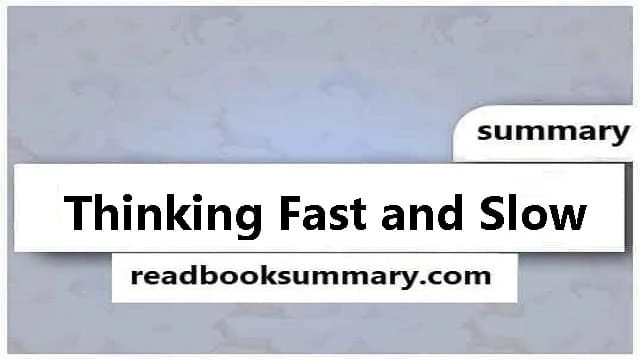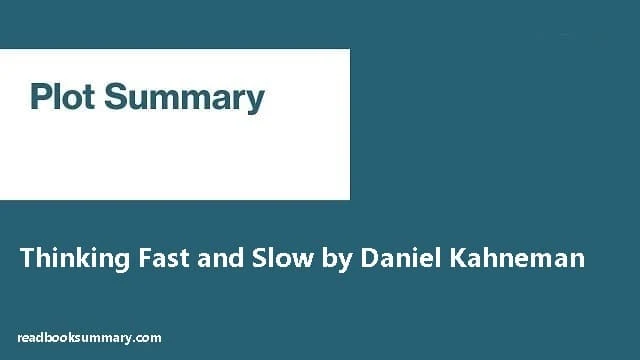Thinking Fast and Slow Summary. it is a 2011 popular science book by psychologist Daniel Kahneman. The book's main thesis is a differentiation between two modes of thought: "System 1" is fast, instinctive and emotional; "System 2" is slower, more deliberative, and more logical.
The book delineates rational and non-rational motivations or triggers associated with each type of thinking process, and how they complement each other, starting with Daniel Kahneman's own research on loss aversion. From framing choices to people's tendency to replace a difficult question with one which is easy to answer, the book summarizes several decades of research to suggest that people have too much confidence in human judgment.
Daniel Kahneman performed his own research, often in collaboration with Amos Tversky, which enriched his experience to write the book. It covers different phases of his career: his early work concerning cognitive biases, his work on prospect theory and happiness, and with the Israel Defense Forces.
 |
| Thinking Fast and Slow Book Summary |
Thinking Fast and Slow Summary
Daniel Kahneman presents the human mind when making decisions through three types of lenses, each represented by one or more parts of the book. The first and third lenses rely on partially opposed, partially collaborative “characters” that Kahneman crafts to represent facets of the human mind.
In Part 1, he discusses the two systems of thinking, System 1 and System 2. These systems of thinking include the “fast” thinking, intuitive System 1, which governs most decisions most of the time, and the “slow” thinking System 2, which comes into play for careful evaluation, such as one might use to solve a complicated math problem. In Part 5, Kahneman discusses two “selves,” which can be understood as an experiencing self that lives in the moment and a remembering self that is more evaluative and draws on the memory’s storage of past experiences.
In between these two presentations of the mind as divided, Kahneman discusses a vast array of complex psychological processes that constitute how people actually—and often illogically—make decisions. Parts 2, 3, and 4 tour the heuristics, biases, illusions, and aspects of human thinking that frequently lead to illogical decisions and other errors.
Part 4 reviews much of Kahneman’s work with Amos Tversky in developing prospect theory, which showed the errors of then-dominant economic theory. This work, which incorporates psychological insights into the study of decision-making, has since blossomed into behavioral economics and influenced a range of other disciplines as well as public policy.
In some instances, Daniel Kahneman and Tversky were the first to reveal certain biases or illusions, and in other instances they built on the findings of others. Broadly speaking, though, no one has done more to illuminate the mechanisms underlying consistent errors in human judgment, which is necessary to taking any corrective action.
Kahneman discusses, to some degree, the policy developments related to the concepts he helped to pioneer. He also provides an overview of the evolving concept of human well-being, research in which he has also participated robustly. Throughout the book, Kahneman offers practical insights that will help people make better decisions, avoid being misled, and focus energy where it can make the most difference in one’s life.
You may also like to read: Crucial Conversations Book Summary
Thinking Fast and Slow Themes
Intuition, Deliberation, and Laziness: Daniel Kahneman’s primary aim in Thinking, Fast and Slow is to explain human problem-solving, decision-making, and behavioral economics for those without psychology degrees. In order to do that, Kahneman first introduces readers to two ways in which people think, which he calls “System 1” and “System 2.” System 1 handles involuntary, automatic processing, and is often associated with intuition. Peoples’ intuitions are often right, but in certain circumstances, System 1 makes key judgmental errors.
Human Fallibility and Overconfidence: After introducing the two modes of thinking he calls “System 1” and “System 2,” Kahneman illuminates some of the underlying fallacies people rely on as they process information. In addition to humans’ natural tendency towards laziness, people also tend to be overconfident in their abilities to correctly answer questions and make calculations. This overconfidence leads not only to biased conclusions based on a person’s subjective experiences, but often leads to outright error.
Stories and Subjectivity vs. Statistics and Objectivity: Humans are natural storytellers; they attempt to make sense of the world by attaching stories to events that occur. Because of this, Kahneman explains, humans have a difficult time reckoning with purely statistical or numerical information and they underestimate the randomness in the world. One of the biggest difficulties that people face in making decisions or analyzing data is when they are presented with statistical information in conjunction with a narrative about the same principle.
Choices, Losses, and Gains: In 2002, Kahneman won the Nobel Prize in Economics for his work in behavioral economics, namely his development of prospect theory with Amos Tversky. Prior to prospect theory, economic theorists believed that the value of money was the sole determinant in explaining why people buy, spend, and gamble in the way that they do.
 |
| thinking fast and slow summary |
 |
| thinking fast thinking slow summary |
Questions and Answers about Thinking Fast and Slow Book
What is fast thinking and slow thinking and which of these is the most important? Fast thinking is a primal survival mechanism that uses heuristics, or cognitive shortcuts, to quickly respond to threats. It's fast but those shortcuts are ultimately unreliable. In contrast, slow thinking requires considerable attention and delivers a more accurate understanding.
Is Thinking, Fast and Slow a hard book to read? As usual difficulty level is relatable, it's all about interest. But let's get deep… Yes this book is quite challenging to your brain as it contradicts the thinking pattern of our brain which we have been practicing since our birth. “It is so far the most original work I have read.
What is the conclusion of Thinking, Fast and Slow? In the end, Kahneman shows that our brains are highly evolved to perform many tasks with great efficiency, but they are often ill-suited to accurately carry out other mental tasks; in fact, our thinking is riddled with behavioral fallacies.
What are the fast and slow thinking parts of the brain? Think of system 1 as the “fast brain” and system 2 as the “slow brain”. The fast brain roughly equates to the unconscious mind and drives 95 per cent of behaviour. Heuristics, or mental shortcuts, are the thoughtless, energy-efficient routines that help you save your strength for the difficult questions.
What is the biggest lesson from thinking fast and slow? The main takeaway from Thinking Fast and Slow is that situations and experiences change, but human nature is constant. Bubbles and busts have been happening since the dawn of financial markets and they will continue to happen going forward.
What is the thesis of thinking fast and slow? Thinking, Fast and Slow is a 2011 popular science book by psychologist Daniel Kahneman. The book's main thesis is a differentiation between two modes of thought: "System 1" is fast, instinctive and emotional; "System 2" is slower, more deliberative, and more logical.
What is the meaning of fast thinking? adjective. inclined to make sensible decisions very quickly, esp in a dangerous or difficult situation.
What is the meaning of slow thinking? Slow thinking is more deliberate, requiring "attention to the effortful mental activities that demand it, including complex computations." It kicks in when you focus, pay attention, monitor and control your behavior, formulate an argument, solve a problem, or do anything that causes your brain to exert itself.
What is the difference between fast thinkers and slow thinkers? Fast thinking (dubbed System 1 by Kahneman) is unconscious, emotional, instinctive. Fast thinking results in snap judgments and, sometimes, prejudice. Slow thinking (System 2) is what most of us would consider actual thought: it's conscious, deliberative, and mostly rational.
What are the two types of Thinking, Fast and Slow? We have a Two System way of thinking — System 1 (Thinking Fast), and System 2 (Thinking Slow). System 1 is the intuitive, “gut reaction” way of thinking and making decisions. System 2 is the analytical, “critical thinking” way of making decisions.
What are the rules of Thinking, Fast and Slow? In his book, Kahneman argued that human reasoning operates on two models. The “thinking fast” (System 1) approach uses predefined rules, or shortcut mental heuristics. “Thinking slow” (System 2) reasoning requires deliberation, thought, and a decision process.
